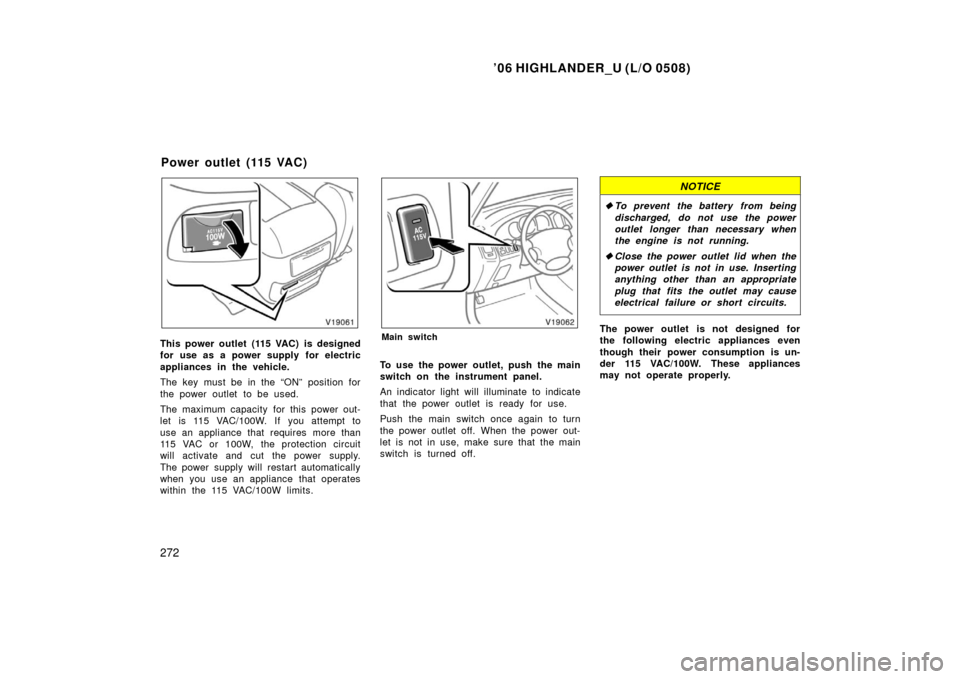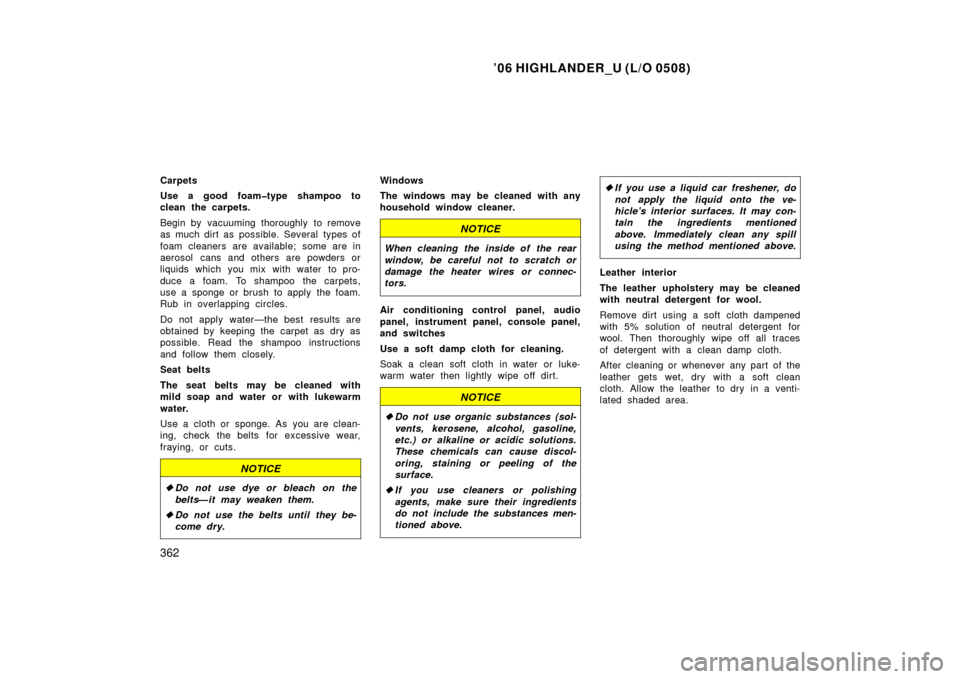Page 282 of 428

’06 HIGHLANDER_U (L/O 0508)
272
This power outlet (115 VAC) is designed
for use as a power supply for electric
appliances in the vehicle.
The key must be in the “ON” position for
the power outlet to be used.
The maximum capacity for this power out-
let is 115 VAC/100W. If you attempt to
use an appliance that requires more than
115 VAC or 100W, the protection circuit
will activate and cut the power supply.
The power supply will restart automatically
when you use an appliance that operates
within the 115 VAC/100W limits.Main switch
To use the power outlet, push the main
switch on the instrument panel.
An indicator light will illuminate to indicate
that the power outlet is ready for use.
Push the main switch once again to turn
the power outlet off. When the power out-
let is not in use, make sure that the main
switch is turned off.
NOTICE
�To prevent the battery from being
discharged, do not use the power
outlet longer than necessary when
the engine is not running.
� Close the power outlet lid when the
power outlet is not in use. Inserting
anything other than an appropriate
plug that fits the outlet may cause
electrical failure or short circuits.
The power outlet is not designed for
the following electric appliances even
though their power consumption is un-
der 115 VAC/100W. These appliances
may not operate properly.
Power outlet (115 VAC)
Page 283 of 428
’06 HIGHLANDER_U (L/O 0508)
273
�
Appliances with high initial peak watt-
age: cathode−
ray tube type televisions,
compressor −driven refrigerators, electric
pumps, electric tools, etc.
�Measuring devices which process pre-
cise data: medical equipment, measur-
ing instruments, etc.
�Other appliances requiring an extremely
stable power supply: microcomputer −
controlled electric blankets, touch sen-
sor lamps, etc.
Certain electrical appliances may cause
radio noise.
To use the glove box:
Open by pulling the lever.
Lock by inserting the master key and turn-
ing it clockwise.
Unlock by inserting the master key and
turning it counterclockwise.
With the instrument panel lights on, the
glove box light will come on when the
globe box is open.
CAUTION
To reduce the chance of injury in
case of an accident or a sudden stop,
always keep the glove box door
closed while driving.
Glove box
Page 288 of 428
’06 HIGHLANDER_U (L/O 0508)
278
Type A (ceiling)
Type B (instrument panel)
Type C (rear console)
Type D (rear console)
Type E (luggage compartment)
Page 311 of 428
’06 HIGHLANDER_U (L/O 0508)
301
The brake pad wear limit indicators on
your disc brakes give a warning noise
when the brake pads are worn to where
replacement is required.
If you hear a squealing or scraping noise
while driving, have the brake pads
checked and replaced by your Toyota
dealer as soon as possible. Expensive ro-
tor damage can result if the pads are not
replaced when necessary.The vehicle identification number (VIN)
is the legal identifier for your vehicle.
This number is on the left top of the
instrument panel, and can be seen
through the windshield from outside.
This is the primary identification number
for your Toyota. It is used in registering
the ownership of your vehicle.The vehicle identification number (VIN) is
also on the Certification Label.
Brake pad wear limit
indicators Your Toyota’s identification—
—Vehicle identification
number
Page 323 of 428

’06 HIGHLANDER_U (L/O 0508)
313
When stowing cargo and luggage in
the vehicle, observe the following:
� Put cargo and luggage in the lug-
gage compartment when at all
possible. Be sure all items are se-
cured in place.
� Be careful to keep the vehicle bal-
anced. Locating the weight as far
forward as possible helps maintain
balance.
� For better fuel economy, do not
carry unneeded weight.
CAUTION
�To prevent cargo and l uggage
from sliding forward during
braking, do not stack anything
in the luggage compartment
higher than the seatbacks.
Keep cargo and luggage low,
as close to the floor as pos-
sible.
� Never allow anyone to ride in
the luggage compartment. It is
not designed for passengers.
They should ride in their seats
with their seat belts properly
fastened. Otherwise, they are
much more likely suffer seri-
ous bodily injury, in the event
of sudden braking or a colli-
sion.
� Do not place anything on the
flattened seat, or it may slide
forward during braking.
�Do not place anything on the
luggage cover. Such items may
be thrown about and possibly
injure people in the vehicle
during sudden braking or an
accident. Secure all items in a
safe place.
� Do not drive with objects left
on top of the instrument panel.
They may interfere with the
driver’s field of view. Or they
may move during sharp vehicle
acceleration or turning, and im-
pair the driver’s control of the
vehicle. In an accident they
may injure the vehicle occu-
pants.
� Do not put objects in the con-
tainer which can shift, roll out
or be thrown out in the event
of sudden stops or accidents.
Objects which come out of the
container can create a safety
hazard due to interference with
pedal operation or driver dis-
traction.
Cargo and luggage—
—Stowage precautions
Page 372 of 428

’06 HIGHLANDER_U (L/O 0508)
362
Carpets
Use a good foam�type shampoo to
clean the carpets.
Begin by vacuuming thoroughly to remove
as much dirt as possible. Several types of
foam cleaners are available; some are in
aerosol cans and others are powders or
liquids which you mix with water to pro-
duce a foam. To shampoo the carpets,
use a sponge or brush to apply the foam.
Rub in overlapping circles.
Do not apply water—the best results are
obtained by keeping the carpet as dry as
possible. Read the shampoo instructions
and follow them closely.
Seat belts
The seat belts may be cleaned with
mild soap and water or with lukewarm
water.
Use a cloth or sponge. As you are clean-
ing, check the belts for excessive wear,
fraying, or cuts.
NOTICE
�Do not use dye or bleach on the
belts —it may weaken them.
� Do not use the belts until they be-
come dry.
Windows
The windows may be cleaned with any
household window cleaner.
NOTICE
When cleaning the inside of the rear
window, be careful not to scratch or
damage the heater wires or connec-
tors.
Air conditioning control panel, audio
panel, instrument panel, console panel,
and switches
Use a soft damp cloth for cleaning.
Soak a clean soft cloth in water or luke-
warm water then lightly wipe off dirt.
NOTICE
�Do not use organic substances (sol-
vents, kerosene, alcohol, gasoline,
etc.) or alkaline or acidic solutions.
These chemicals can cause discol-
oring, staining or peeling of the
surface.
� If you use cleaners or polishing
agents, make sure their ingredients
do not include the substances men-
tioned above.
�If you use a liquid car freshener, do
not apply the liquid onto the ve-
hicle’s interior surfaces. It may con-
tain the ingredients mentioned
above. Immediately clean any spill
using the method mentioned above.
Leather interior
The leather upholstery may be cleaned
with neutral detergent for wool.
Remove dirt using a soft cloth dampened
with 5% solution of neutral detergent for
wool. Then thoroughly wipe off all traces
of detergent with a clean damp cloth.
After cleaning or whenever any part of the
leather gets wet, dry with a soft clean
cloth. Allow the leather to dry in a venti-
lated shaded area.
Page 419 of 428
’06 HIGHLANDER_U (L/O 0508)
409
Engine compartment
Instrument panel
Fuses (type A)
1. A/F 25 A: Air fuel ratio sensor
2. CRT 7.5 A: Rear seat entertainment
system, navigation system
3. STARTER 7.5 A: Multiport fuel injection
system/se quential multiport fuel injec-
tion system
4. EFI NO.2 10 A: Multiport fuel injection
system/se quential multiport fuel injec-
tion system
5. ETCS 10 A: Multiport fuel injection
system/se quential multiport fuel injec-
tion system
Engine compartment
(with daytime running light system)
6. RR HTR 15 A: Rear air conditioning
system
7. H�LP RH LWR 15 A: Right−hand head-
light (low beam)
8. H�LP LH LWR 15 A: Left−hand head-
light (low beam)
9. ALT�S 7.5 A: Charging system
10. POWER OUTLET2 20 A: Power outlets
11. TOWING 20 A: Trailer lights
12. HORN 10 A: Horns
13. SECURITY 15 A: Theft deterrent sys-
tem
Fuses
Page 420 of 428

’06 HIGHLANDER_U (L/O 0508)
410
14. H�LP RH UPR 10 A: Right−hand head-
light (high beam)
15. ECU·B 7.5 A: Theft deterrent system,
air conditioning system, gauges and
meters, multiplex communication sys-
tem, electronic moon roof, front pas-
senger occupant classification system
16. EFI NO.1 20 A: Multiport fuel injection
system/s equential multiport fuel injec-
tion system, fuel pump
17. DOOR LOCK 25 A: Power door lock
system, theft deterrent system
18. H�LP LH UPR 10 A: Left−hand head-
light (high beam)
19. RAD NO.1 25 A: Audio system
20. DOME 10 A: Personal lights, interior
lights, vanity lights, ignition switch light,
wireless remote control system, gauges
and meters, navigation system
21. HAZARD 15 A: Emergency flashers,
instrument panel light, trailer lights
22. SPARE 7.5 A: Spare fuse
23. SPARE 15 A: Spare fuse
24. SPARE 25 A: Spare fuse 25. IGN 10 A:
Gauges and meters, SRS
airbag system, multiport fuel injection
system/se quential multiport fuel injec-
tion system, front passenger occupant
classification system
26. RAD NO.2 7.5 A: Audio system, shift
lock system, navigation system, rear
seat entertainment system, air condi-
tioning system, multiplex communica-
tion system
27. CIG 15 A: Cigarette lighter
28. P RR DOOR 20 A: Power windows
29. PWR OUTLET1 15 A: Power outlets
30. FR FOG 20 A: Front fog lights
31. ECU�IG 10 A: Electric moon roof,
anti −lock brake system, vehicle stability
control system, shift lock system,
charging system, starting system
32. WIPER 25 A: Windshield wipers and
washer
33. D RR DOOR 20 A: Power windows
34. D FR DOOR 25 A: Power windows,
door courtesy lights, power door lock
system
35. S/ROOF 20 A: Electric moon roof 36. HEATER 10 A:
Air conditioning system,
electric cooling fan, rear window defog-
ger, outside rear view mirror defogger,
gauges and meters
37. IG1 7.5 A: Back−up lights, vehicle sta-
bility control system, multiport fuel in-
jection system/sequential multiport fuel
injection system, outside rear view mir-
ror heaters, power door lock system,
wireless remote control system, naviga-
tion system, multiplex communication
system
38. RR WIP 15 A: Rear window wiper
39. STOP 20 A: Stop lights, high mounted
stoplight, anti −lock brake system, ve-
hicle stability control system, shift lock
system, trailer lights, multiplex commu-
nication system, multiport fuel injection
system/s equential multiport fuel injec-
tion system
40. OBD 7.5 A: On−boar
d diagnosis sys-
tem
41. SEAT HTR 15 A: Seat heaters
42. IG2 15 A: Multiport fuel injection sys-
tem/sequential multiport fuel injection
system, charging system, starter sys-
tem
43. WASHER 20 A: Low windshield washer
fluid level warning light